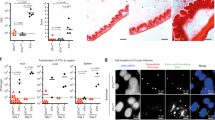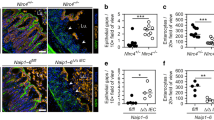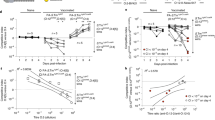Abstract
Genetically encoded antibiotic peptides are evolutionarily ancient and widespread effector molecules of immune defence1,2,3. Mammalian defensins, one subset of such peptides, have been implicated in the antimicrobial defence capacity of phagocytic leukocytes and various epithelial cells4, but direct evidence of the magnitude of their in vivo effects have not been clearly demonstrated. Paneth cells, specialized epithelia of the small intestinal crypt, secrete abundant α-defensins and other antimicrobial polypeptides5,6 including human defensin 5 (HD-5; also known as DEFA5)7,8,9. Although antibiotic activity of HD-5 has been demonstrated in vitro9,10, functional studies of HD-5 biology have been limited by the lack of in vivo models. To study the in vivo role of HD-5, we developed a transgenic mouse model using a 2.9-kilobase HD-5 minigene containing two HD-5 exons and 1.4 kilobases of 5′-flanking sequence. Here we show that HD-5 expression in these mice is specific to Paneth cells and reflects endogenous enteric defensin gene expression. The storage and processing of transgenic HD-5 also matches that observed in humans. HD-5 transgenic mice were markedly resistant to oral challenge with virulent Salmonella typhimurium. These findings provide support for a critical in vivo role of epithelial-derived defensins in mammalian host defence.
This is a preview of subscription content, access via your institution
Access options
Subscribe to this journal
Receive 51 print issues and online access
$199.00 per year
only $3.90 per issue
Buy this article
- Purchase on SpringerLink
- Instant access to full article PDF
Prices may be subject to local taxes which are calculated during checkout



Similar content being viewed by others
References
Boman, H. G. Peptide antibiotics and their role in innate immunity. Annu. Rev. Immunol. 13, 61–92 (1995)
Meister, M., Hetru, C. & Hoffmann, J. A. The antimicrobial host defense of Drosophila. Curr. Top. Microbiol. Immunol. 248, 17–36 (2000)
Zasloff, M. Antimicrobial peptides of multicellular organisms. Nature 415, 389–395 (2002)
Lehrer, R. I., Bevins, C. L. & Ganz, T. in Mucosal Immunology (eds Ogra, P. L., Mestecky, J., Lamm, M. E., Strober, W. M. & Bienstock, J.) 89–99 (Academic, New York, 1998)
Ayabe, T. et al. Secretion of microbicidal α-defensins by intestinal Paneth cells in response to bacteria. Nature Immunol. 1, 113–118 (2000)
Porter, E. M., Bevins, C. L., Ghosh, D. & Ganz, T. The multifaceted Paneth cell. Cell. Mol. Life Sci. 59, 156–170 (2002)
Jones, D. E. & Bevins, C. L. Paneth cells of the human small intestine express an antimicrobial peptide gene. J. Biol. Chem. 267, 23216–23225 (1992)
Porter, E., Liu, L., Oren, A., Anton, P. & Ganz, T. Localization of human intestinal defensin 5 in Paneth cell granules. Infect. Immun. 65, 2389–2395 (1997)
Ghosh, D. et al. Paneth cell trypsin is the processing enzyme for human defensin-5. Nature Immunol. 3, 583–590 (2002)
Porter, E., van Dam, E., Valore, E. & Ganz, T. Broad spectrum antimicrobial activity of human intestinal defensin 5. Infect. Immun. 65, 2396–2401 (1997)
Ouellette, A. J. & Bevins, C. L. in Development of the Gastrointestinal Tract (eds Sanderson, I. R. & Walker, W. A.) 147–164 (Decker, Hamilton, Ontario, 1999)
Mallow, E. B. et al. Human enteric defensins: gene structure and developmental expression. J. Biol. Chem. 271, 4038–4045 (1996)
Wilson, C. L. et al. Regulation of intestinal α-defensin activation by the metalloproteinase matrilysin in innate host defense. Science 286, 113–117 (1999)
Darmoul, D. & Ouellette, A. J. Positional specificity of defensin gene expression reveals Paneth cell heterogeneity in mouse small intestine. Am. J. Physiol. 271, G68–G74 (1996)
Wang, M. S., Pang, J. S. & Selsted, M. E. Semidry electroblotting of peptides and proteins from acid-urea polyacrylamide gels. Anal. Biochem. 253, 225–230 (1997)
Cole, A. M. & Ganz, T. Human antimicrobial peptides: analysis and application. Biotechniques 29, 822–831 (2000)
Porter, E. M. et al. Isolation of human intestinal defensins from ileal neobladder urine. FEBS Lett. 434, 272–276 (1998)
Cunliffe, R. N. et al. Human defensin 5 is stored in precursor form in normal Paneth cells and is expressed by some villous epithelial cells and by metaplastic Paneth cells in the colon in inflammatory bowel disease. Gut 48, 176–185 (2001)
Satoh, Y., Habara, Y., Ono, K. & Kanno, T. Carbamylcholine- and catecholamine-induced intracellular calcium dynamics of epithelial cells in mouse ileal crypts. Gastroenterology 108, 1345–1356 (1995)
Ouellette, A. J., Satchell, D. P., Hsieh, M. M., Hagen, S. J. & Selsted, M. E. Characterization of luminal Paneth cell α-defensins in mouse small intestine: attenuated antimicrobial activities of peptides with truncated amino termini. J. Biol. Chem. 275, 33969–33973 (2000)
Selsted, M. E., Miller, S. I., Henschen, A. H. & Ouellette, A. J. Enteric defensins: antibiotic peptide components of intestine host defense. J. Cell Biol. 118, 929–936 (1992)
Putsep, K. et al. Germ-free and colonized mice generate the same products from enteric prodefensins. J. Biol. Chem. 275, 40478–40482 (2000)
Nizet, V. et al. Innate antimicrobial peptide protects the skin from invasive bacterial infection. Nature 414, 454–457 (2001)
Couto, M. A., Liu, L., Lehrer, R. I. & Ganz, T. Inhibition of intracellular Histoplasma capsulatum replication by murine macrophages that produce human defensin. Infect. Immun. 62, 2375–2378 (1994)
Bals, R., Weiner, D. J., Moscioni, A. D., Meegalla, R. L. & Wilson, J. M. Augmentation of innate host defense by expression of a cathelicidin antimicrobial peptide. Infect. Immun. 67, 6084–6089 (1999)
Kisich, K. O., Heifets, L., Higgins, M. & Diamond, G. Antimycobacterial agent based on mRNA encoding human β-defensin 2 enables primary macrophages to restrict growth of Mycobacterium tuberculosis. Infect. Immun. 69, 2692–2699 (2001)
Taketo, M. et al. FVB/N: an inbred mouse strain preferable for transgenic analyses. Proc. Natl Acad. Sci. USA 88, 2065–2069 (1991)
Harper, M. E., Barrera-Saldana, H. A. & Saunders, G. F. Chromosomal localization of the human placental lactogen-growth hormone gene cluster to 17q22-24. Am. J. Hum. Genet. 34, 227–234 (1982)
Bevins, C. L., Jones, D. E., Dutra, A., Schaffzin, J. & Muenke, M. M. Human enteric defensin genes: chromosomal map position and a model of possible evolutionary relationships. Genomics 31, 95–106 (1996)
Iwabuchi, Y., Katagiri, M. & Masuhara, T. Salivary secretion and histopathological effects after single administration of the muscarinic agonist SNI-2011 in MRL/lpr mice. Arch. Int. Pharmacodyn. Ther. 328, 315–325 (1994)
Acknowledgements
We acknowledge the technical assistance of J. Russell, S. Lee, D. Wilk, H. deJong and K. Carver. We thank J. Crabb and S. Yadav for their help with peptide analysis, and T. Ganz and E. Porter for discussions and for providing us with recombinant peptides and the polyclonal anti-HD-5 antibody. We also acknowledge discussions with S. Miller and A. Ouellette. This work was supported by grants from the National Institutes of Health (to C.L.B. and N.H.S.) and The Crohn's and Colitis Foundation of America (to N.H.S.). A portion of this work was completed while the indicated authors were at the Departments of Microbiology (N.H.S.) and Pediatrics (N.H.S., C.L.B.), University of Pennsylvania, School of Medicine and the Children's Hospital of Philadelphia, Philadelphia, Pennsylvania, USA.
Author information
Authors and Affiliations
Corresponding author
Ethics declarations
Competing interests
The authors declare that they have no competing financial interests.
Rights and permissions
About this article
Cite this article
Salzman, N., Ghosh, D., Huttner, K. et al. Protection against enteric salmonellosis in transgenic mice expressing a human intestinal defensin. Nature 422, 522–526 (2003). https://doi.org/10.1038/nature01520
Received:
Accepted:
Published:
Issue Date:
DOI: https://doi.org/10.1038/nature01520
This article is cited by
-
The oral microbiome in autoimmune diseases: friend or foe?
Journal of Translational Medicine (2023)
-
Decreased Paneth cell α-defensins promote fibrosis in a choline-deficient L-amino acid-defined high-fat diet-induced mouse model of nonalcoholic steatohepatitis via disrupting intestinal microbiota
Scientific Reports (2023)
-
Inadvertent nucleotide sequence alterations during mutagenesis: highlighting the vulnerabilities in mouse transgenic technology
Journal of Genetic Engineering and Biotechnology (2021)
-
IL-22 receptor signaling in Paneth cells is critical for their maturation, microbiota colonization, Th17-related immune responses, and anti-Salmonella immunity
Mucosal Immunology (2021)
-
Decrease of α-defensin impairs intestinal metabolite homeostasis via dysbiosis in mouse chronic social defeat stress model
Scientific Reports (2021)



